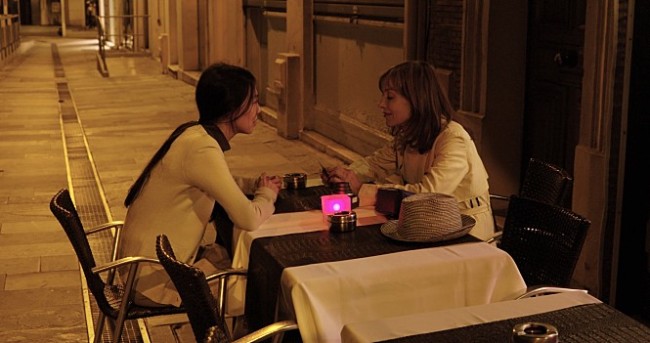A camera is a curious thing. One may think he or she is making a copy of reality, but it is in fact a modified version of it. A photograph may show a happy couple, but they could be smiling to cover their animosity toward each other. It is only through a person’s perspective that a photograph takes meaning.
“Claire’s Camera,” directed by Hong Sang-soo, is a film emblematic of the Korean auteur’s style, conjuring up a vague air of mystery for what is captured through the titular character’s lens.
 |
| “Claire’s Camera” (Jeonwonsa Film) |
 |
| “Claire’s Camera” (Jeonwonsa Film) |
Claire, played by Isabelle Huppert, is a cheery Parisian on her first trip to Cannes — a chuckle-worthy concept for one of the greatest actresses in French cinema. Her camera strays from the glamour of the Cannes Film Festival and lingers instead on the quiet empty beaches and people, specifically a trio of Koreans.
Jung Jin-young’s So Wan-soo looks to be a charming director but is a raging alcoholic who is rather pathetic, and Man-hee — played by Kim Min-hee — is an attractive young woman who is mistreated by the world. Man-hee has just been fired by her boss Yang-hye — played by Chang Mi-hee as a woman whose smile can chill you to the bones — for Man-hee’s unspecified “mistake.” It is later revealed that Man-hee and Wan-soo — Yang-hye’s boyfriend — shared a one-night stand.
The couple of Wan-soo and Yang-hye share little screen time with Man-hee, as they are tied together by their repeated encounters with Claire. Is it a huge coincidence for a French woman to repeatedly run into three people conjoined by a baggage of emotions, or is she the puppeteer politically triggering the emotional chaos? Like Wan-soo, the director remains sly about it.
Just as in his other films, Hong’s acute observation of subtle details, seemingly pointless dialogue and the way his camera lingers work to provoke thought. The camera focuses on the actors for the audience to take in every bit of body language, to observe subtle clues, awkward movements and the cautious choice of words.
The film’s opening scene shows Man-hee being fired in a most cryptic fashion. “Even though I still think you’re pure at heart, I’ve come to realized that’s no guarantee of your honesty,” Yang-hye says, and the only way to understand the conversation is through observation of the words being uttered.
As always, Hong leaves most of his work open for interpretation. From the audience’s perspective, the vague and cryptic scenes take meaning, which means the film can feel differently dependent on the viewer.
Several times in the film, Claire suggests something or someone is strange, and only after she points it out do others take notice. It may have been a subtle hint at the film-making in general, as the director’s perspective invites others to interpret what is captured through his or her camera.
“The only way to change things is to look at everything again very slowly,” Claire says, a point worth pondering.
On a different note, I’ve always suspected that Hong owes at least some part of the brilliance in his work to happenstance, as he is famous for his quick shooting and changing many things on the fly. That is not on any level to say that his works are the product of luck, but I feel like it is through the audience’s own view of his work that the films are completed.
This is actually why Hong’s films work so well. He allows the audience to think, to see the films through their own lens and give the work a different perspective — just as Claire can be seen forming her own impression of her new friends in “Claire’s Camera.”
“Claire’s Camera” opens in local theaters Wednesday.
By Yoon Min-sik
(minsikyoon@heraldcorp.com)



